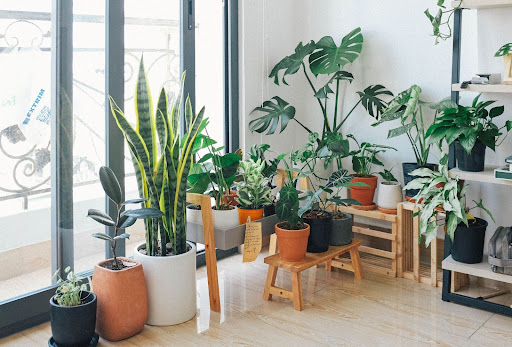As we grow older, our priorities and preferences often shift, and one area of life where this is especially true is in our living spaces. As seniors, we may find ourselves downsizing our homes or simply opting for a more relaxed and low-maintenance lifestyle. However, this doesn’t mean we have to sacrifice the benefits and beauty of nature within our homes. In fact, houseplants can provide a myriad of benefits for seniors, including improved air quality, mental well-being, and a touch of vibrant color to our living spaces.
This blog post will explore the best houseplants that fit a senior lifestyle, taking into account factors such as easy maintenance, health benefits, and space requirements.
Spider Plant (Chlorophytum Comosum)
The spider plant is a top choice for seniors due to its minimal maintenance requirements and impressive air-purifying abilities. This resilient plant thrives in a variety of lighting conditions, making it perfect for areas with limited natural light. The spider plant is also great at removing toxins such as formaldehyde and benzene from the air, contributing to a healthier living environment. It’s one of many available houseplants with next-day delivery.
Care: Place your spider plant in a location with indirect sunlight, and water it moderately. Allow the soil to dry between waterings, as overwatering can lead to root rot.
Snake Plant (Sansevieria)
The snake plant, also known as mother-in-law’s tongue, is another excellent choice for seniors. It’s not only visually striking but also highly effective at purifying the air.
Snake plants are known to remove toxins such as formaldehyde, xylene, and benzene, and they even release oxygen at night, making them a fantastic addition to bedrooms.
Care: Snake plants prefer indirect sunlight but can tolerate low-light conditions. Water sparingly, allowing the soil to dry out between waterings. Be cautious of overwatering, as this can lead to root rot.
Peace Lily (Spathiphyllum)
The peace lily is a beautiful houseplant that boasts elegant white flowers and glossy green leaves. It’s a popular choice for seniors as it’s easy to care for and highly effective at purifying the air.
In fact, the peace lily is known to remove toxins such as ammonia, formaldehyde, and benzene, all while improving the overall humidity in your home.
Care: Peace lilies thrive in low to medium light and should be kept away from direct sunlight. Water the plant when the soil feels dry, but avoid overwatering, as this can lead to root rot.
ZZ Plant (Zamioculcas Zamiifolia)
The ZZ plant is a fantastic option for seniors looking for a hardy, low-maintenance houseplant. With its thick, waxy leaves and ability to tolerate low light conditions, the ZZ plant is a great choice for those who don’t have the time or ability to care for more demanding plants.
While it’s not as effective as other options for air purification, the ZZ plant is still a visually appealing addition to any living space.
Care: The ZZ plant prefers indirect sunlight and can even thrive in low-light conditions. Water sparingly, allowing the soil to dry out completely between waterings to avoid root rot.
Pothos (Epipremnum Aureum)
Pothos, also known as devil’s ivy, is a versatile and hardy houseplant that’s well-suited to a senior lifestyle. Its trailing vines make it an attractive addition to shelves or hanging baskets, while its low-maintenance nature ensures that it’s easy to care for.
Pothos is also an effective air purifier, removing toxins such as formaldehyde, xylene, and benzene from the environment.
Care: Pothos plants thrive in indirect sunlight, but they can also tolerate low-light conditions. Water your pothos when the soil feels dry, and avoid overwatering to prevent root rot.
Philodendron (Philodendron Spp.)
Philodendrons are another excellent option for seniors due to their easy-care nature and air-purifying abilities. These attractive plants come in a variety of shapes and sizes, from the heart-leaf philodendron to the larger selloum philodendron.
They are known for their ability to remove toxins such as formaldehyde from the air, making them a healthy addition to your home.
Care: Philodendrons prefer indirect sunlight and can tolerate low-light conditions. Water the plant when the soil feels dry, but be cautious of overwatering, as this can lead to root rot.
Rubber Plant (Ficus Elastica)
The rubber plant is a visually appealing option for seniors, with its large, glossy leaves and sturdy structure. This low-maintenance plant is not only beautiful but also effective at purifying the air, and removing toxins such as formaldehyde, benzene, and ammonia.
Care: Rubber plants prefer bright, indirect sunlight and well-draining soil. Water the plant when the top inch of soil feels dry, and be mindful of overwatering, as this can cause root rot.
Dracaenas (Warneckii Dracaena)
Dracaena are long-lived, low-maintenance plants that make great houseplants. Due to their tropical charm, they’re popular indoor plant choices for offices and shopping centers alike.
One of the most sought-after dracaenas is Warneckii, featuring glossy green strappy leaves with white pinstriped markings that slightly arch. This captivating house plant can grow up to six feet tall and looks great as a standalone specimen or in mixed seasonal containers.
Care: Indirect sunlight is ideal for this plant, as direct light can burn the foliage or cause it to fade. Furthermore, regular watering of this plant will help ensure its healthy root system.
To prevent overwatering, keep a close eye on the soil and water only when it appears dry at the top. This will guarantee your plant has optimal growing conditions and prevent rot or brown leaf stains caused by too frequent watering.
Bird Of Paradise (Strelizia nicolai)
Bird of Paradise, commonly known as Strelitzia reginae or, is an easy-to-grow houseplant with an evergreen tropical appearance that requires minimal care and maintenance. Perfect for beginners or those seeking a tropical touch in their home decor, this plant makes an excellent choice.
Strelitziaceae family, this flower can be found throughout tropical regions around the world. It produces stunning blooms that resemble birds in flight.
Care: Grow this plant indoors or outdoors, provided it receives adequate sunlight and regular watering. It also makes an ideal addition to a container garden.
Orchids
Orchids are a favorite indoor houseplant due to their hardiness, ease of care, and stunning flowers.
Care: Plants thrive in a range of conditions and require varying amounts of light, watering and humidity. Overwatering can cause roots to rot while lack of humidity can prevent blooms.
Furthermore, they can be vulnerable to fungus gnats, insects such as spider mites and mealybugs, etc. To help combat these issues, spray your plants monthly with Physan (mix 1 teaspoon per gallon).
Orchids are primarily herbaceous and may be terrestrial, epiphytic or lithophytic. Their leaves vary in size, color, and shape to adapt to varying lighting conditions; some prefer sunlight while others seek shade.
Leaves of those species that bask in sunlight tend to be thick, leathery and covered with a waxy cuticle which helps retain moisture; by contrast, leaf blades of those that thrive in shade tend to be thin, long, and flexible.
Conclusion
Houseplants can provide numerous benefits for seniors, including improved air quality, mental well-being, and an aesthetically pleasing living environment. The plants listed above are all excellent options for a senior lifestyle, as they are low-maintenance, visually appealing, and effective at purifying the air. By selecting the right houseplants and providing proper care, you can create a harmonious and healthy living space that brings the beauty of nature into your home.

























